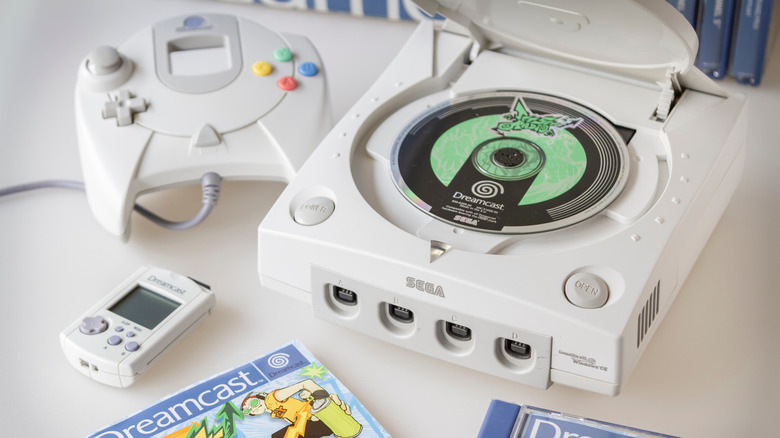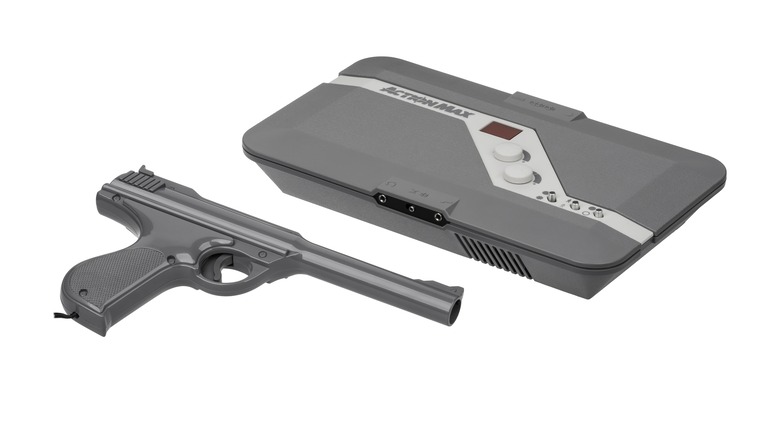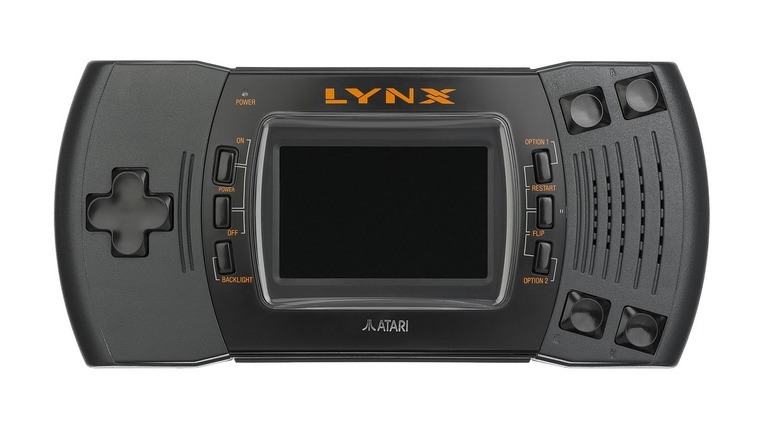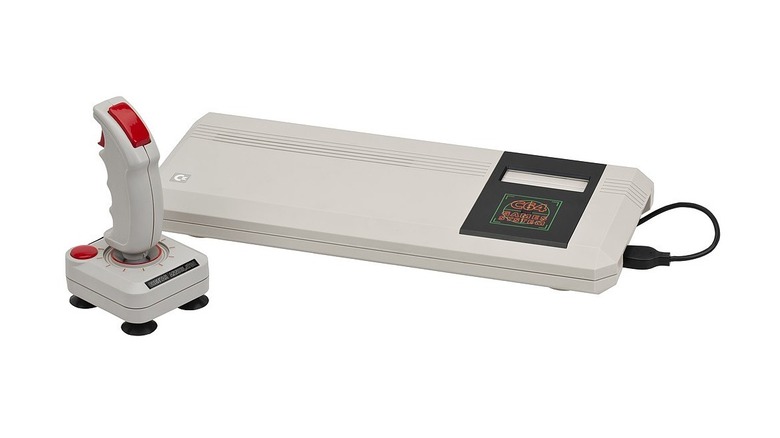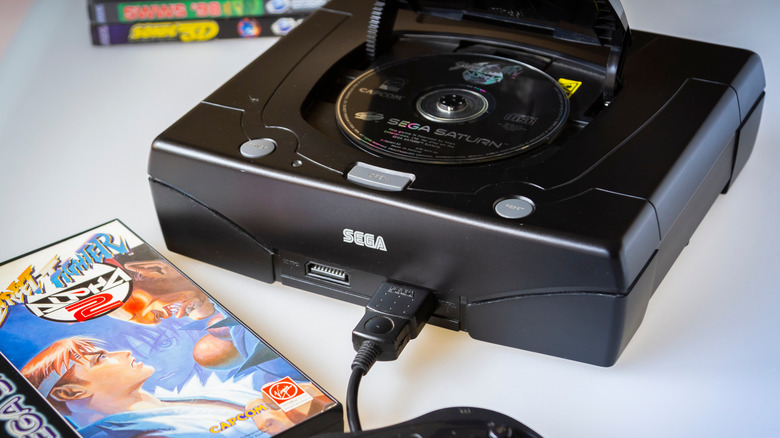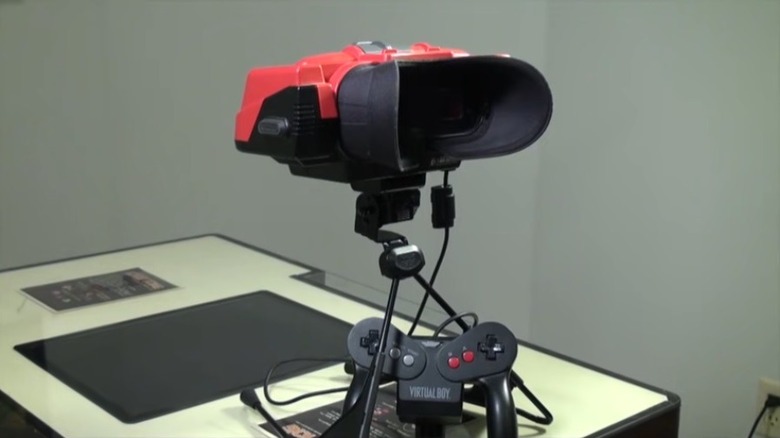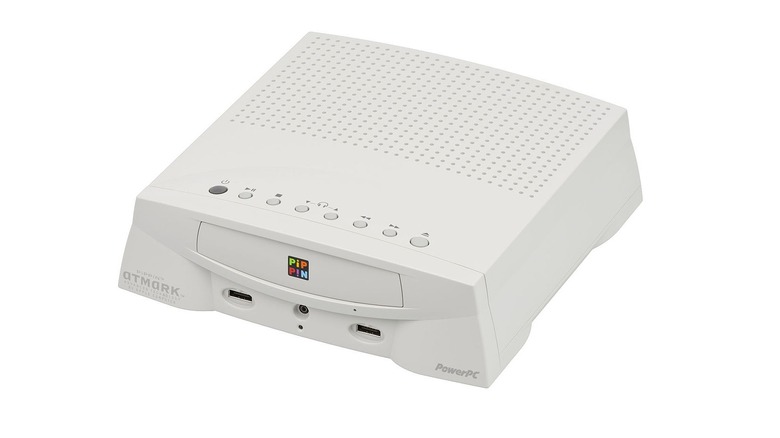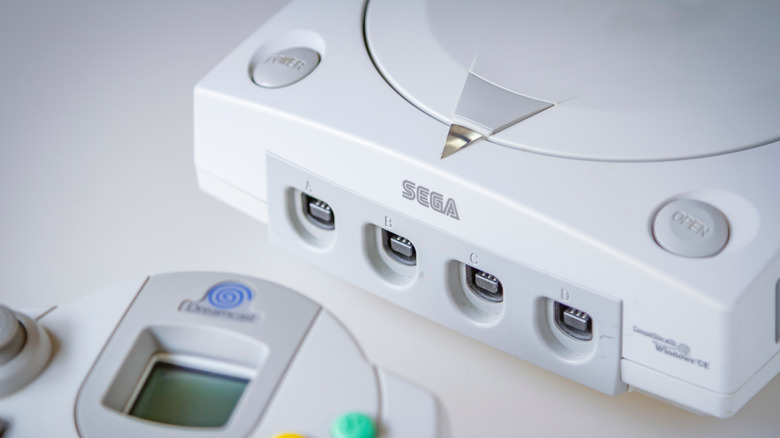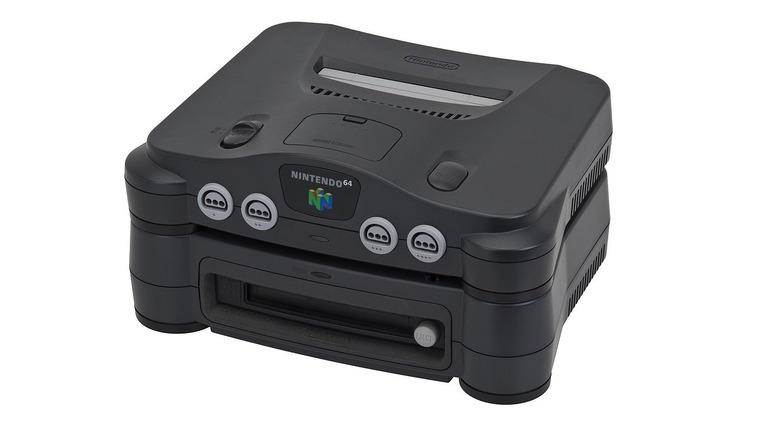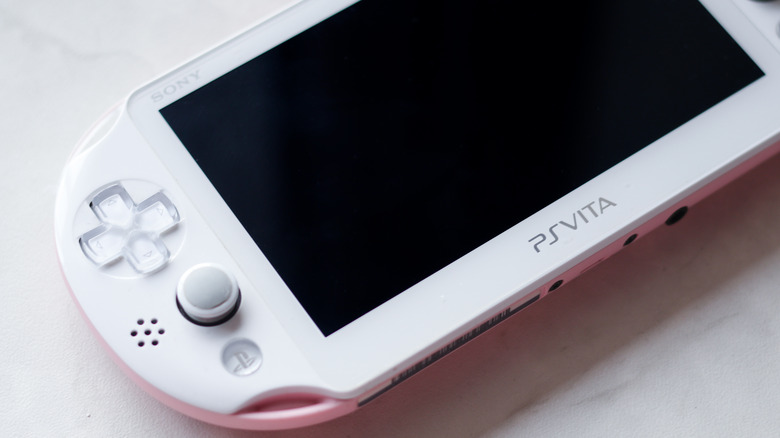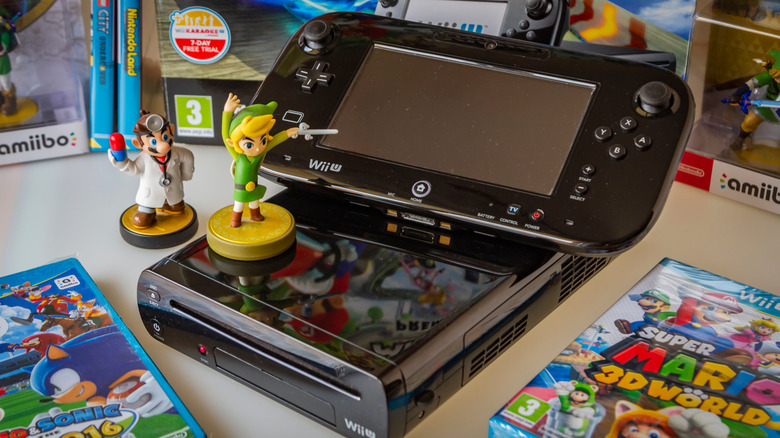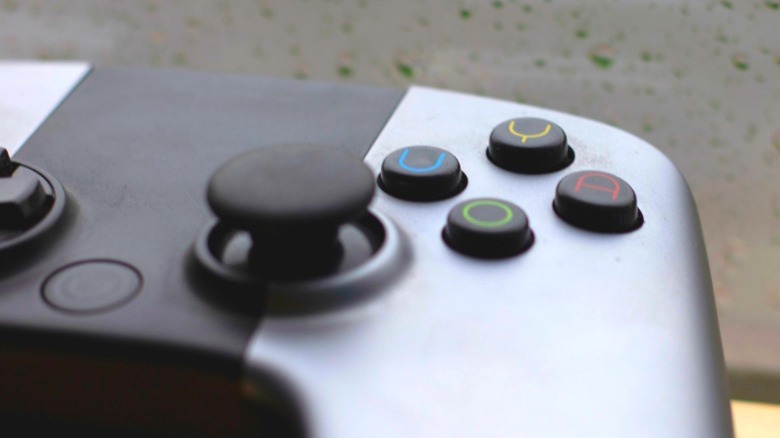The Biggest Game Console Flops Of All Time
In the not-so-distant past, when video games were still young, the only place you could play them was at an arcade. You'd ride your bike there after school, or on the weekends, with a pocket full of quarters and a head full of dreams. You'd while away the hours traversing pixelated dungeons, and fighting poorly-rendered aliens. Then, something wonderful happened.
The first commercial at-home gaming console was invented in the form of the Magnavox Odyssey (via Computer Museum of America). The technology enjoyed an initial burst of popularity, spawning competitors like Atari, but the future of home video games wasn't certain. Then companies like Nintendo and Sega, and later Sony and Microsoft, found the right formula, and transformed video games into a seemingly permanent part of the cultural landscape.
That doesn't mean that every console created by those companies, or their competitors, has been a hit. For every success, there have been a handful of failures, pieces of tech which were either ahead of their time, wildly misguided, or mismanaged and doomed to the trash heap. Some of these you'll likely remember, others have been forgotten to time, and that might be for the best.
Action Max
By the late '80s, video game systems had found their footing. The Nintendo Entertainment System, for instance, was released in 1983, and has sold nearly 62 million units worldwide (via Nintendo). As a result, players had become familiar with the cartridge-style games common to that and other consoles.
It's curious, then, that in 1987, Worlds of Wonder took an entirely different approach. Its console, the Action Max, tossed away the familiar cartridges in favor of games built on VHS tapes. The console connected to your television via the VCR, and utilized a light gun to interact with the game (via Video Game Console Library).
Five games were produced, each of which played out on the tape, and continued toward their climax regardless of the player's actions. The only real evidence that the player was contributing at all was a flashing sprite which appeared each time the light gun's trigger was squeezed.
From a certain point of view, the VHS game model was innovative, offering the improved graphics of a live-action movie compared to the pixelated worlds and characters of their competitors, but it lacked interactivity. The game loops were repetitive with little to no means of altering gameplay. That's a risky thing to sacrifice, considering that gamers are looking for interactivity above just about everything else. Consequently, the Action Max tanked.
Atari Lynx
Home consoles took games out of the arcade and into the living room, but it wasn't until 1989 when things truly went mobile. Early that year, Nintendo launched the Game Boy, a system that went on to spawn plenty of descendants, some of which are alive and well today. Hoping to maintain its foothold in the gaming market, Atari launched its own handheld device in the fall of 1989.
The Lynx, as it was called, should have been a sure thing. It boasted a full-color backlit display, which stood in stark contrast to the monochrome display of the Game Boy. It also had the ability to flip the screen if you turned it upside down, allowing left-handed gamers to play with the d-pad on the right side, and the buttons on the left. Not to mention, the Lynx ran in 16-bit while Nintendo was still handing out 8-bit games (via Engadget).
While the Lynx had the Game Boy beat in terms of pure functionality, Atari made the same kind of mistake as the Action Max, leaning too heavily on form factor and not heavily enough on actual gameplay. The Lynx had limited titles, and it couldn't compete with such emerging darlings as the "Super Mario" series. It also absolutely chewed through batteries, making the overall experience less enjoyable even if it was prettier. Despite its superior tech, it simply didn't stand a chance.
Commodore 64 Games System
The Commodore 64 is most well-known today as an old-timey computer, but it was a good gaming system in its own right. Users could insert games, and play them on the C64 by utilizing the keyboard and other peripherals (via Gizmodo). Then, in 1990, the company set its sights on the home gaming market.
The Commodore 64 Games System was largely a reskinned C64 with a joystick in place of the keyboard. It played all of the same games as the original C64 with the notable exception that you couldn't play any game that required the keyboard. What's more, if you wanted to play games on the Commodore, you could get the computer for about the same price as the Games System, and enjoy the added functionality (via Old-Computers.com). Some games were produced specifically for the Games System, but they were sparse. That meant Commodore was competing with the NES and the Sega Genesis, both of which had dedicated games titles and were purposely made for home gaming.
Perhaps Commodore thought it was a worthwhile risk, given that it didn't have to go through the trouble of constructing a new device to dip its toes in the gaming pool. In any event, the experiment failed, and the C64 Gaming System sold less than a quarter of the 80,000 units produced before it went belly up.
Sega Saturn
By the early '90s, Sega had established itself as a key player in the gaming market due in no small part to the popularity of the Sega Genesis, and its hallmark character, Sonic. Schoolyard rivalries hinged on whether you were a Nintendo kid or a Sonic kid, and while Nintendo ultimately won out, the Genesis did well in the marketplace, selling roughly 29 million units over its lifetime (via IGN).
As the next generation of consoles was poised to hit store shelves, Sega was making plans for its next device in the form of the Sega Saturn. In 1994, the Saturn was released to considerable fanfare in Japan, selling out the initial run of 200,000 units (via Game Informer). But, that's when things went off the rails.
As Game Informer explains, Sony was about to release the first PlayStation, and executives at Sega got scared. Consequently, they released the Saturn earlier than they'd originally planned in hopes of beating Sony to market. The cobbled-together release meant it was only available at certain retailers at launch time, and without the robust game lineup necessary to support a console launch. What's worse, the PlayStation launched shortly after with a lower price point.
By 1998, the Saturn was discontinued, having only sold 9 million units as compared to 100 million for the PlayStation.
Virtual Boy
By the mid-'90s, Nintendo was more than a decade into dominating the home gaming space, but the cracks were starting to show. Sony's first PlayStation console had just dropped and was primed to bump Nintendo from its top spot. Of course, the Nintendo 64 would release in 1996 to much success, but in the meantime, Nintendo was trying its hand at something truly bizarre with the Virtual Boy.
Virtual reality gaming is only just gaining some ground almost three decades later, now that the technology has somewhat caught up with ambition. But in 1995, none of that was true. Despite the limitations, Nintendo attempted to deliver on immersive 3D gaming by strapping a console to the player's face. While it offered a version of virtual reality, users were forced to trade in comfort and all but black and red colors for the privilege.
According to AV Club, that's because the graphics would have been unstable if they'd been offered in full color, and red LEDs were cheap. The real kicker, as is the case in so many console failures, was the poor lineup of games. A total of 22 titles were produced for the Virtual Boy, and many of them didn't work well with the 3D effect, or else suffered from the monochrome display. By 1996, the Virtual Boy was discontinued. Some reports say it only sold around 770,000 units. It remains an interesting relic of gaming history, if an unsuccessful one.
Apple Bandai Pippin
Apple might be a top tech giant today, but that wasn't yet the case in 1996 when it partnered with toy manufacturer Bandai to break into the gaming market. Their console, dubbed the Pippin, was built on the foundation of Apple's Mac computers, but didn't have any internal operating system. Instead, all the heavy lifting was done by the games themselves (via Insider).
The effort reeks of Commodore's earlier mistake, leveraging existing technologies in the home computer space to try and gain a toehold in gaming. Like the C64 Games System before them, the effort failed. The Pippin played ported games from the Mac and utilized an interesting controller, complete with a mouse trackball.
The Pippin wasn't all bad: It did have some cool features, like the ability to play games regardless of region. That meant you could buy games from other countries and play them anywhere, something which still isn't available by default on most consoles. Ultimately, the Pippin offered too little, and cost too much. Per Insider, it retailed for $600, twice as much as the PlayStation (via PSU) and three times as much as the N64. Consumers weren't having it, and the Pippin only sold 42,000 units before calling it quits a year after launch.
Sega Dreamcast
The Dreamcast was actually a fairly good console, making it all the more surprising that it failed. That was partly due to Sega losing its footing with the Saturn, but had more to do with some questionable design decisions and a changing market.
Electronic Arts pulled out of the console in advance of the launch over what it deemed red flags. Even still, the Dreamcast had some pretty impressive games, including a more than serviceable port of the arcade game "House of the Dead 2."
The killing blow for the Dreamcast came from the hardware. While the games were played on discs, the console was incapable of playing DVDs (via CBR). When Sony included that feature in the PlayStation 2, it went a long way toward winning over consumers (via The Gamer). When it came time to buy a gaming console, whether or not it could also play movies was a deciding factor for many.
Worse still, the Dreamcast suffered from lackluster piracy protection. Per CBR, users quickly discovered they could burn games onto a standard CD-R and share them with friends. The impact of this on game sales is likely impossible to determine, but it certainly couldn't have helped. All told, the Dreamcast sold about 6.5 million units before Sega decided to halt production. When the Sega Dreamcast died, so did Sega's console efforts (via CBR). Since then, the company has focused on making games for other platforms.
Nintendo 64DD
The Nintendo 64 did pretty well on its own, selling roughly 33 million units over its lifetime (via Venture Beat), but the same can't be said for the Nintendo 64DD. It was less a console in its own right, and more an add-on to the Nintendo 64, which promised to upgrade Nintendo's flagship device to a next-gen console.
According to IGN, it allowed players to pull images from the TV, make 3D models, and even build their own levels for some games. It also included primitive internet connectivity, allowing players to share what they created with other gamers. If the 64DD had been released at or close to the time of the Nintendo 64's release, it might have been a game changer, but time waits for no console.
It was originally planned for release in 1997, only a year after the Nintendo 64's release, but didn't actually hit shelves until 1999. Even then, it only came out in Japan and never made its way to the states. Delays meant that the hardware was dated by the time it hit shelves, and only about 15,000 units were sold. The Nintendo 64DD was officially a failure. Ultimately, many of the titles intended for the DD were simply released on the standard Nintendo 64 later on.
PS Vita
Following the success of Sony's first handheld, the PSP, the company hoped to get another win with the PlayStation Vita. On paper, it should have been a contender in the handheld market, but a few things went awry along the way.
The Vita was fighting an uphill battle from the start against the reigning champion of gaming handhelds, Nintendo. The DS remains the highest-selling handheld of all time, with more than 154 million units sold (via Visual Capitalist). It's among the highest-selling consoles of all time, handheld or otherwise. In an effort to compete, the Vita doubled down on functionality, and it wasn't any slouch.
In addition to having cutting-edge graphics, for the time, users could also use the Vita for remote play. With a wireless connection, the Vita could connect to your PS4 and play nearly any game from anywhere in the world as long as both the PS4 and the Vita were connected to the internet. When at home, you could also use the Vita as a secondary screen, displaying peripheral information from your games (via PlayStation).
All it needed was a robust game library of its own to supplement the objectively cool additional functionality it gave your primary console, and that's where Sony failed. In response to the rising popularity of mobile gaming on cell phones, Sony squandered the Vita, pulling first-party games just four years after its release (via TheGamer).
Wii U
In the years leading up to the release of the Wii U, Nintendo was riding high. At the time, the Wii was the best-selling home console Nintendo had ever produced, having sold more than 100 million units (via Nintendo). All Nintendo needed to do was keep the momentum going, but the Wii U failed to capture the same excitement from the gaming community.
There were a couple of components at play in the failure. One was confusion about what exactly the Wii U was. According to Nintendo, some consumers believed that the tablet-style controller was a peripheral device for the Wii, rather than a component of an entirely new console. Perhaps more important was the failure to release key titles on a quick enough timeline. By this point, one would think console manufacturers would understand the importance of releasing with a strong enough library, but even Nintendo appears to have stumbled on that mark.
The console launched with 23 titles, but only one of those was from the flagship "Super Mario" franchise (via Nintendo Life). These factors conspired to make the Wii U a failure, selling only 13.56 million units. This was Nintendo's worst-selling console of all time aside from the Virtual Boy. Luckily for Nintendo, and for us, the company learned from those mistakes in time to give the world the Switch.
Ouya
When the Ouya first hit the public consciousness in 2012, it seemed destined to be the next big thing in gaming. It managed a successful Kickstarter campaign, raising more than $8.5 million — roughly six times its funding goal — from over 63,000 backers.
It promised users a formidable console for $99 (via The Verge). The Ouya endeavored to connect gamers with developers, granting access to independently created games, many of which would be free. It almost sounded too good to be true, and that should have been a warning.
While the Ouya did eventually ship as promised, it failed to meet many of the hardware and software promises it had made. Perhaps even worse, the console hit shelves before it was shipped to backers, something which might have felt like a slap in the face to the very people who made it possible (via Crowdfund Insider). Still, people got their consoles, and they might have been happy if the game library had been as promised. Unfortunately, many found the offerings left them wanting.
Things got worse as indie developers jumped ship to PlayStation and Xbox, both of which made efforts to get indie games on their platforms. The Ouya ecosystem just couldn't continue to sustain itself, and the servers shuttered in 2019 (via SVG).
